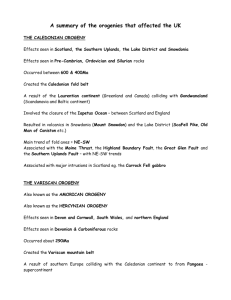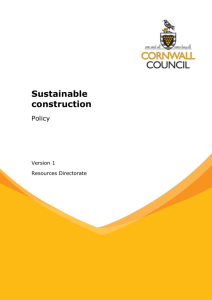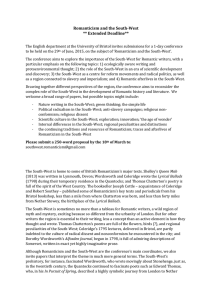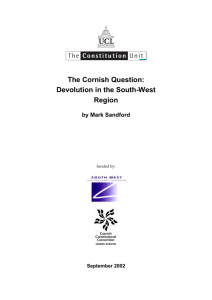HOVERFLIES
advertisement
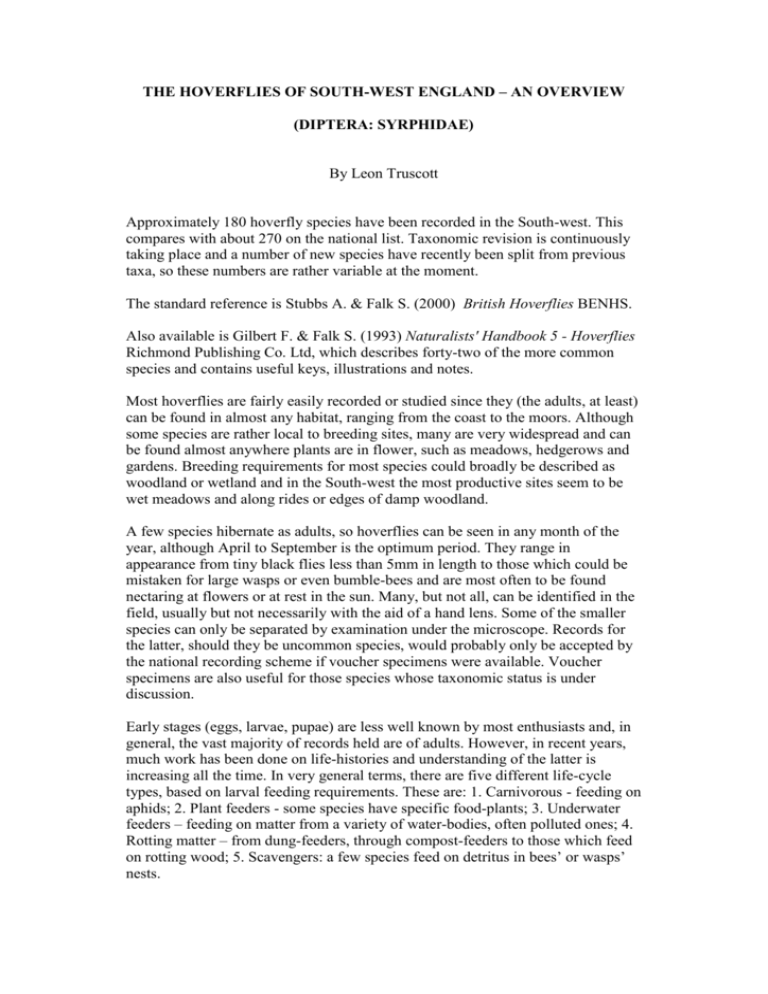
THE HOVERFLIES OF SOUTH-WEST ENGLAND – AN OVERVIEW (DIPTERA: SYRPHIDAE) By Leon Truscott Approximately 180 hoverfly species have been recorded in the South-west. This compares with about 270 on the national list. Taxonomic revision is continuously taking place and a number of new species have recently been split from previous taxa, so these numbers are rather variable at the moment. The standard reference is Stubbs A. & Falk S. (2000) British Hoverflies BENHS. Also available is Gilbert F. & Falk S. (1993) Naturalists' Handbook 5 - Hoverflies Richmond Publishing Co. Ltd, which describes forty-two of the more common species and contains useful keys, illustrations and notes. Most hoverflies are fairly easily recorded or studied since they (the adults, at least) can be found in almost any habitat, ranging from the coast to the moors. Although some species are rather local to breeding sites, many are very widespread and can be found almost anywhere plants are in flower, such as meadows, hedgerows and gardens. Breeding requirements for most species could broadly be described as woodland or wetland and in the South-west the most productive sites seem to be wet meadows and along rides or edges of damp woodland. A few species hibernate as adults, so hoverflies can be seen in any month of the year, although April to September is the optimum period. They range in appearance from tiny black flies less than 5mm in length to those which could be mistaken for large wasps or even bumble-bees and are most often to be found nectaring at flowers or at rest in the sun. Many, but not all, can be identified in the field, usually but not necessarily with the aid of a hand lens. Some of the smaller species can only be separated by examination under the microscope. Records for the latter, should they be uncommon species, would probably only be accepted by the national recording scheme if voucher specimens were available. Voucher specimens are also useful for those species whose taxonomic status is under discussion. Early stages (eggs, larvae, pupae) are less well known by most enthusiasts and, in general, the vast majority of records held are of adults. However, in recent years, much work has been done on life-histories and understanding of the latter is increasing all the time. In very general terms, there are five different life-cycle types, based on larval feeding requirements. These are: 1. Carnivorous - feeding on aphids; 2. Plant feeders - some species have specific food-plants; 3. Underwater feeders – feeding on matter from a variety of water-bodies, often polluted ones; 4. Rotting matter – from dung-feeders, through compost-feeders to those which feed on rotting wood; 5. Scavengers: a few species feed on detritus in bees’ or wasps’ nests. 1. Common species There are about 80 species thought to be common in most of Britain. Almost all of these occur commonly in the south-west. The most well known being members of the Eristalis genus, especially E.tenax and E.pertinax. These ubiquitous hive-bee mimics are particularly common in late summer. Perhaps equally familiar is Episyrphus balteatus. In some years, this species is abundant, as numbers can be boosted by migrants from mid-summer onwards. Episyrphus balteatus 2. Eristalis pertinax Eristalis tenax South-western specialists The distribution of a number of species, although not exclusively south-western, show a distinct bias to this region. I have picked seven examples: a) Arctophila superbiens. A “northern and western” species, mainly of Wales, Scotland and northern England. Most records for southern England are from Cornwall, Devon and Dorset. b) Callicera aurata. A rare species of central southern England. It has been recorded from Devon and Cornwall in recent years. c) Chrysotoxum elegans. A scarce species of southern England & Wales. Although there are a few records from woodland and scrub from south-east England, its strongholds are south-western coasts. d) Eristalinus aeneus. A coastal species, mainly of the southern half of Britain, which can be found all round the south-western coast. e) Eristalis cryptarum. This is very much a south-western, indeed an exclusively Devonian species! There are old records from Cornwall, Devon, Dorset and Hampshire, but there were none since the 1960s until 1993, when it was re-discovered on Dartmoor. It has since been found in several Dartmoor locations. f) Eumerus sabulonum. Another coastal species. Nearly all records are from the coasts of west Wales and Devon & Cornwall. g) Microdon myrmicae. A scarce species of some southern and western districts, usually on wet heath. The larvae feed in ants’ nests on eggs and grubs. 3. Southern species scarce in the South-west Some species, although frequent in southern England, are scarce in the south-west, even though habitat requirements appear to be met. Either the latter is not the case, or they are simply under-recorded. The following five are worth looking out for: a) Chalcosyrphus nemorum. A woodland species I have found almost annually in low numbers. b) Chrysotoxum cautum. A species of grassland & hedgerows. Fairly common in most of southern England, but strangely local in the south-west, especially Devon. Seems to prefer high hedgerows in Cornwall. c) Criorhina floccosa. A woodland species, and, although scarce, records are very widespread, but few are from the south-west. d) Didea fasciata. Like the previous fly, a scarce, but widespread woodland species. Records from the south-west are few. e) 4. Volucella inflata. Another woodland species. Records are mainly concentrated around central southern England, but there are a few recent records from Devon and Cornwall. Scarce, but increasing species Some species have extended their range in recent years. The classic example is Volucella zonaria. Britain’s largest hoverfly, it became established in the London area in the 1940s and has gradually spread westwards, reaching Devon and Cornwall in the 1990s. Scaeva selenitica and Xanthandrus comtus are two species whose records have increased in recent years, especially on the coast, often in late summer, suggesting migration. Scaeva selenitica Volucella zonaria Xanthandrus comtus Of course, the distribution picture for hoverflies in general is far from complete, and the national database is being continuously updated. Records should be sent to the National Hoverfly Recording Scheme. The organisers are Dr Stuart Ball, 255 Eastfield Road, Peterborough, PE1 4BH and Mr Roger Morris, 7 Vine Street, Stamford, Lincs PE9 1QE. Leon Truscott 59 Cremyll Road, Torpoint, Cornwall PL11 2DZ Leon.truscott@btinternet.com

